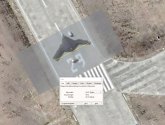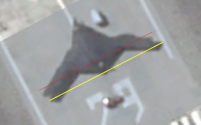GJ-X could potentially also easily carry the notional 1000km range AAM we discussed not long ago, a concept also looked at (and tested?) across the pond recently.Speaking of GJ-X being unmanned arsenal aircrafts for AAMs, similar ideas have indeed been brought up on the other side of the lake just a couple weeks ago:
So, yes - Something like the GJ-X should be able to carry at the very least a few AAMs inside its IWBs. And given the overall length of the center-body (~22-24 meters), the GJ-X can actually have an IWB that is ~9-10 meters long.
This would mean that a at least couple PL-17s could be fitted inside the GJ-X's IWB. Though, if we want to go further and utilize the full length of the IWB, that would mean XLRAAMs in the high-hundreds of kilometers (>600 kilometers) of maximum strike ranges. Otherwise, a 9-meter long IWB would enable a longitudinal dual-stacking of PL-15/16 LRAAMs.
This hasn't yet touch on the possibility of either a rotary launcher or vertical dual-stacking of AAMs inside the IWB, but that's a discussion for another time.
In the meantime, though - I'd prefer something in between the GJ-11/21 and GJ-X in terms of dimension, MTOW and payload capacity for such roles. This should make the platform not just being a viable and significant upgrade in terms of payload capacity and range/endurance over the GJ-11/21, but also not as expensive and is less prone to attrition than the GJ-X to enable procurement in greater numbers.
You are using an out of date browser. It may not display this or other websites correctly.
You should upgrade or use an alternative browser.
You should upgrade or use an alternative browser.
Chinese UCAV/CCA/flying wing drones (ISR, A2A, A2G)
- Thread starter VESSEL
- Start date
Speculative bomber wingman theories aside it seems pretty likely to me this thing will be fully capable of carrying out strike missions on its own by design, ie any possible CCA role being secondary with autonomous strike missions being primary capability rather than other way around. Anything else would make very little sense with (among other things) the number of simultaneous sorties/targets prosecuted being severely limited (by number of available H-20s), crippling the otherwise invaluable 2-3IC strike capability this would afford.I don’t think it is unmanned H-20 but rather bomber equivalent to CCA that could follow H-20 on long range strategic missions. There are two variants of drone — one to provide ISR and the other to carry additional munition. H-20 will be the control node for the two drones.
GJ-X could potentially also easily carry the notional 1000km range AAM we discussed not long ago, a concept also looked at (and tested?) across the pond recently.
Looked at yes, though I don't think they have actually tested such missiles.
Looked at yes, though I don't think they have actually tested such missiles.
Anyway... you need to lock targets and at this range and it will be quite hard.
Maybe it could be done by data link with support aircrafts closer to the target to get it home. In that case, being stealthy is not a big gain with a 1000km AAM, an H6 would do the trick in most cases.
A see a CCA launched far from land from a H6 with a couple of shorter range missiles way better than a huge missile on an expensive rig with support aircrafts in the kill zone.
As I said if you want to compare two measures you need to use the same process and same tools and/or know the tolerance.Like this

You have done a poor job of overlaying it. You need to make sure it's precise. Use transparency tools to make it more accurate if needed.
View attachment 162953
Using the same overlay method via GE you get 44.5m wingspan for both, with unknown tolerance but probably +/- 1m
In other words either both are closer to 46m or both are closer to 40m
You can't simply compare measures by one party using one tool against measures by another party using another tool.


I’m not entirely sure why we are so fixated on the exact size when the it is obvious that GJ- is a B-21 class aircraft. That’s enough for me.
As I said if you want to compare two measures you need to use the same process and same tools and/or know the tolerance.
Using the same overlay method via GE you get 44.5m wingspan for both, with unknown tolerance but probably +/- 1m
In other words either both are closer to 46m or both are closer to 40m
You can't simply compare measures by one party using one tool against measures by another party using another tool.
View attachment 162963View attachment 162964
That's because you measured the shadow and not the airframe. If you measure the airframe, it comes out to be ~42 and ~45 for B-21
I imagine TWZ also measured the airframe itself. You can make a case for either but at this point we're limited by the quality of the images and should just leave it at that. When newer and more precise information comes out, we can update our understanding.

JH-X likely got split between J-36 and GJ-XNo way this is true. Cause the whole notion of a "strategic bomber" is to perform strategic strikes, that is, nuclear strikes. China just barely got going on a Nuclear triad but on a stopgap tactical Bomber like the H-6. As a Nuclear power equal to Russia and US, they also want a strategic bomber with the range and payload capacity to strike adversaries on the other side of the globe.
And it doesn't take a genius to figure out that a drone will never be doing nuclear strikes. So, you need a manned Bomber with the range and payload capacity to be able to strike US mainland.
China might have given up on the JH-X project, a tactical stealth Bomber and likely some drone will replace it. China will likely use GJ-X on conventional strike missions in the second island chain and possibly even Hawaii. But in order to reach CONUS they will need a bigger bomber.
The role of a rapid response supersonic strike platform can be handled well enough by J-36, J-36 can carry YJ-20, YJ-17, and YJ-19, and maybe YJ-21 at supersonic speeds to hit targets of opportunity, this is while being able to defend itself from enemy aircraft.
The role of regional bomber is fit by the GJ-X, especially since the GJ-X can and probably would carry large amounts long range cruise missiles to overwhelm enemy ad at standoff ranges.
With these two roles filled there isn't much point for JH-X to exist.
I assume you understand shadow cast by a source at infinity of an object parallel to the projection surface is 1:1 with the object, i.e. opposite edges of a parallelogram has equal length.That's because you measured the shadow and not the airframe. If you measure the airframe, it comes out to be ~42 and ~45 for B-21
I imagine TWZ also measured the airframe itself. You can make a case for either but at this point we're limited by the quality of the images and should just leave it at that. When newer and more precise information comes out, we can update our understanding.
View attachment 162965
Shadow gives a clean outline that eliminate measurement error from differentiating object against background due to colour and image quality, as I said metrology is a science you need to standardize the process.
I think it's pretty clearly established that both has wingspan within 1-2m of each other, either are both 40-42m or both are 45-46m.
I agree the size difference make no operational difference, as B-21's need for a cockpit, life support and crew access inherently means it has lower performance in both weight and volume.
The issue isn't really that of size, it's that there are Americans who can't handle the idea that GJ-X is larger than B-21, even if its just larger by 1-2m, I have no intention of letting Americans get away with any amount of cope.
The drone being bigger or smaller than the B-21 just appears to be a dick measuring contest at this point or should I say wing measuring. What is important is that it's a bomber sized drone, the outrage online about it being bigger or smaller than the B-21 seems like childish semantics.
Like what siegecrossbow said the exact size in relation to the B-21 doesn't matter. What is important is that it's bomber sized, and the relative capabilities it may have due to these size requirements.
Like what siegecrossbow said the exact size in relation to the B-21 doesn't matter. What is important is that it's bomber sized, and the relative capabilities it may have due to these size requirements.
